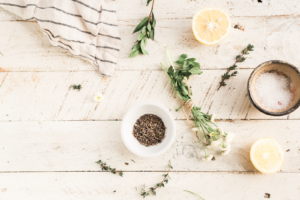Keeping Produce Fresher Longer
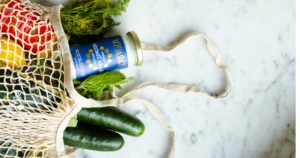
Keeping fresh produce “fresh” can be tricky. In recent months, I have backed off on how many times I grocery shop each month. Keeping fresh produce around for longer than a week can be challenging, but I have started using some of these strategies to keep produce looking and tasting great for weeks!
Storing Produce Properly
Let’s start with how to store your produce! Avoid storing produce at the top of the refrigerator where it is more likely to freeze. Instead, keep fresh produce in the center of the refrigerator to prevent freezing or thawing. Let’s dive into storing techniques for common grocery buys:
- Asparagus: Place in a glass of water (like flowers) and refrigerate until ready to use.
- Carrots: Store in a covered container of water in the refrigerator to keep firm until ready to use. Replace the water every 2 to 3 days.
- Celery: Wrap in aluminum foil to maintain freshness and crunch and keep in the refrigerator for up to 2 to 4 weeks.
- Cucumbers: Store on the countertop at room temperature out of direct sunlight.
- Lettuce/herbs: Place a dry paper towel around to soak up excess moisture that can cause mushiness, molding, or browning. Change towels every 2 to 3 days.
- Mushrooms: Keep in a brown paper bag in the refrigerator to prevent excess moisture causing mushiness, molding, or browning.
- Tomatoes: Store on the countertop at room temperature out of direct sunlight.
- Winter squash/pumpkin/onions/potatoes: keep in a dry, cool space like the pantry or garage. Ensure these foods are not overcrowded and have adequate air circulation to prevent breakdown.
Washing Produce
It is recommended to wait and wash produce prior to using it to prevent excess moisture during the storing process. Berries are a bit different. Try soaking them in a vinegar solution (3 parts water to 1 part vinegar) for 5 to 10 minutes. Fight the urge to rinse the vinegar off. The vinegar helps fight off molding. Don’t worry, you won’t taste the vinegar on your sweet berries. Let berries dry completely. Then, return to a breathable container prior to storing in the refrigerator.
Isolation to Prevent Ripening
Some fruits and vegetables like apples, bananas, pears, and potatoes produce a gas called ethylene. When this gas is released it can cause any produce near it to ripen faster. Prevent this by storing these foods separately in the refrigerator or on the countertop. Alternatively, you can even place these items near avocados if you are impatient like me and ready to devour the avocados before they’re ripened!
Slow Down The Ripening Process
The cold environment of the refrigerator or freezer can allow you to store produce for much longer. Always allow fresh produce like pears, avocados, melons, bananas, peaches to ripen at room temperature first. When at ideal ripeness, transition the produce to the refrigerator until ready to use. Before any produce goes bad, use the freezer to keep it “fresh” until ready to use. Most vegetables need to be blanched before storing in the freezer. Blanching helps halt enzyme activity that impacts flavor and texture; it also helps to clean the produce prior to storing. Put herbs in ice cube molds with olive oil. Chop up green onions and place in a plastic bottle for easy dispensing. Place all produce in an airtight container and use within 6 months.
I hope these strategies are as helpful for you as they have been for my family! LN
Weighing Your Risk – Nutrition, Obesity & COVID-19
At Banister Nutrition, we recognize that a variety of factors play a role in your overall health. As we work alongside our clients, we see first-hand the impact that nutrition has on the ability to positively influence outcomes associated with illness and disease. In fact, as we learn more about COVID-19 and the dynamics that influence both risk and severity, it is confirming our understanding that to best manage our health, we must leverage what we know about nutrition and do what we can now to meet our health goals for today and our future.
When it comes to COVID-19, new evidence may suggest that obese individuals are more likely to be hospitalized and admitted to the intensive care unit (ICU) compared to those who are overweight or of healthy weight. Currently, weight status is defined using the Body Mass Index (BMI) scale which categorizes individuals as underweight, healthy weight, overweight, or obese. By these standards, 42.4% of Americans are currently considered obese. With that being said, it is important to recognize that while BMI does not take into account a person’s body fat percentage, the reality is, there is a strong body of evidence that shows BMI as a reliable indicator of health status and health outcomes. In addition, by dismissing the potential correlation between weight and COVID-19 outcomes, we may be missing an opportunity to protect ourselves and our loved ones. Lastly, multiple studies have shown obesity linked to impaired immune function, decreases lung capacity, and altered sleep patterns, thereby further complicating outcomes associated with COVID-19 – all of which can be positively influenced by nutrition!
At this point, you may be asking – what are some of the links between nutrition and weight, and what can I do to put myself and my loved ones in the best position to fight COVID-19? See our thoughts below on ways to curb your risk by maximizing your sleep, physical activity, and stress management, all through the power of nutrition!
Nutrition, Weight & Sleep
What we know – Insufficient sleep can result in a disruption to the body’s hormone regulation mechanisms including those that control the production of ghrelin and leptin, hormones that help regulate hunger and satiety (or fullness). This can lead to an imbalance in energy and weight gain over time.
What we can do – Try to limit foods that might disrupt your sleep patterns for at least 1-3 hours before bedtime including foods with added caffeine & sugar or those that are greasy or high in saturated fat. Examples include fried foods, soda, and sweets/desserts. On the flip side, foods with quality fiber such as fruits, vegetables, and grains along with healthy fats and protein such as fish, nuts, and seeds may actually improve the quality and duration of sleep.
Nutrition, Weight & Physical Activity
What we know – Daily physical activity, in addition to proper nutrition, supports the growth and development of lean body mass (LBM) which is critical for proper nutrient utilization and a healthy metabolism.
What we can do – The types of foods, as well as the timing of the foods we eat, is important in maximizing your efforts in the gym (or newly designed “home gym”). For example, give your body at least 1-4 hours to eat and process food before working out. Examples of meals/snacks that include a quality protein with a quality carbohydrate are oatmeal with almonds and blueberries or a no-sugar-added Greek yogurt with sliced strawberries.
But don’t stop there! In the first 30 minutes following an intense workout, your body is primed and ready to receive and use an easy to digest (you guessed it) quality protein and a quality carbohydrate source such as a glass of low-fat chocolate milk or even a peanut butter smoothie made with low-fat milk and half a banana. Refueling after a workout is just as important as the meal prior, if not more, in building lean muscle!
Nutrition, Weight & Stress Management
What we know – When our body experiences stress, it begins to produce cortisol which can influence weight management through its impact on appetite signals and the body’s insulin response.
What we can do – Make sure to eat consistently throughout and include foods that help you to feel good which means those that help you to maintain energy levels, support a healthy immune system, and improve cognition and focus. Examples of foods to include daily are those high in fiber and healthy fats with special attention to those with added Vitamin A, C, and zinc for immune and memory support. Examples include citrus fruits, nuts and seeds, as well as omega-3 rich sources such as salmon.
If you or someone you know needs additional support and guidance on the best plan for them, Banister Nutrition is here to help!
Wishing you and your family and happy and healthy holiday season! ~ AS & The Banister Team~
Strong Immune System Against COVID-19
In the current state of the world, health is at the forefront of everyone’s mind. Our health is directly dependent on the essential role of our immune system. It relies on complex interworkings of cells, organs, proteins, and tissues to recognize and neutralize harmful viruses, bacteria, cell changes, and other organisms that cause disease.
Our immune system is such an elaborate system of many interconnected parts that requires balance and harmony. Our desire is to live a healthy lifestyle that builds a strong immune system in order to fight off the coronavirus or other harmful substances should we come in contact with them.
Our immune system also operates better when bolstered by healthy lifestyle choices.
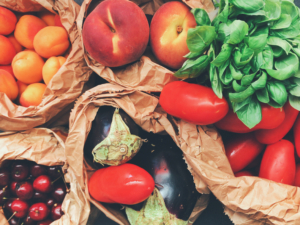
Healthy ways to reinforce a strong immune system to prevent or fight COVID-19 include:
A Healthy Diet
Our diet is key to a strong immune system. Be certain to eat at least 5-6 servings of fruits and vegetables daily, legumes, whole grains, lean protein, and healthy fats.
Micronutrients
Numerous nutrients, vitamins, and minerals are required to support the normal functioning of your immune system Some micronutrients that play a role in maintaining your immune system include:
- Vitamin B6 –found in chickpeas, chicken or turkey, salmon, tuna, bananas, green vegetables, potatoes (with skin)
- Vitamin C – found in oranges, grapefruit, lemons, limes, kiwi pineapple, strawberries, tomatoes, broccoli, spinach, red peppers, Brussel sprouts
- Vitamin E – found in almonds, sunflower and safflower oil, sunflower seeds, peanuts peanut butter, spinach, asparagus, red bell pepper, avocado, trout, mango
- Zinc – found in foods including oysters, crab, lobster, beef, pork chop, chicken, baked beans, beans, nuts, yogurt, Swiss cheese. Some evidence indicates zinc may have a beneficial role in the immune response
- Vitamin D – found in fortified foods such as dairy products, orange juice, soy milk, and cereals. A maintenance dose of vitamin D is vital during the winter months as well as for those with low vitamin D levels.
Exercise
One way exercise may improve the immune system is by boosting your overall circulation making it easier for immune cells to travel more easily throughout your body. Studies have shown 30 minutes of moderate to vigorous exercise daily helps stimulate your immune system.
Water
Water is a necessary component of your lymph system which carries infection-fighting immune cells around your body.
Sleep
Important infection-fighting molecules are created while you sleep. Inadequate sleep leaves you more prone to getting sick.
Minimize Stress
Chronic long term stress over an extended period is certainly bad for our health. The uncertainty we are now experiencing with COVID-19 can trigger a stress response. The secretion of cortisol suppresses your immune system, thus increasing your chance of infection or illness. Given that stress has a direct negative impact on your health it is important to know how to identify your stress and have treatment options that work for you.
In addition, continue to minimize trips outside your home, practice social distancing, and wash your hands frequently. If you do come in contact with the virus, you’ve already taken proactive steps to have a strong and healthy immune system that can strengthen your defense against this harmful disease.
CB
Flavor Without The Sodium
February is American Heart Month!
In celebration, I would like to provide you with some great seasoning tips that help reduce or even eliminate sodium from the diet. Leave the “it won’t taste like food” comments at the door. Herbs are a great way to season dishes with an explosion of flavor.
Protip: Use herbs to liven up the presentation of any dish.
Let me introduce some common herbs found at the grocery store (and are also very easy to grow from your own backyard):
Parsley
- Flavor: fresh, grassy
- How to use: wash, chop the leaves and stem (stem can be used)
- What to season: sauces, salads, garnishes, mushrooms, peas, potatoes, tomatoes, cucumbers, zucchini, lamb, beef, chicken, fish, tofu
Cilantro
- Flavor: bright and citrusy
- How to use: wash, strip the leaves from the stem, discard the stem and chop the leaves
- What to season: salsas, guacamole, chutneys, soups, curries, salads, avocado, tomatoes, bell pepper, chicken, fish, shellfish, lamb, lentils, tofu
Oregano
- Flavor: pungent, peppery
- How to use: wash, strip the leaves from the stem, discard the stem and chop the leaves
- What to season: tomato sauces, pizzas, salad dressings, artichokes, bell peppers, eggplant, mushrooms, tomatoes, potatoes, zucchini, chicken, beef, lamb, fish
Rosemary
- Flavor: woody, pungent
- How to use: wash, strip the leaves from the stem, discard the stem and chop the leaves
- What to season: focaccia bread, tomato sauces, pizza, soups, stews, roasted veggies, mushrooms, peas, tomatoes, potatoes, chicken, lamb, pork, fish
Thyme
- Flavor: minty
- How to use: wash, strip the leaves from the stem, discard the stem and chop the leaves
- What to season: rice, dips, stews, roasted veggies, tomato sauces, carrots, peas, potatoes, winter squash, tomatoes, chicken, pork, lamb, duck, fish
Mint
- Flavor: sweet, cool
- How to use: wash, strip the leaves from the stem, discard the stem and chop the leaves
- What to season: fruit salads, curries, cream sauces, soups, marinades, carrots, eggplant, watermelon, mushrooms, tomatoes, potatoes, zucchini, beans, lentils, lamb
Basil
- Flavor: sweet and peppery flavor
- How to use: wash, remove the leaves from the stems and discard the stems. To prevent burning, add to your dishes near the end of cooking.
- What to season: pestos, tomato sauces, soups, stews, stir-fries or curries. Can also be used to add flavor to bell peppers, eggplant, tomatoes, zucchini, chicken, beef, fish or tofu
LN
Cranberry Jalapeno Relish
 Cranberries are rich in vitamin C, dietary fiber, and manganese.
Cranberries are rich in vitamin C, dietary fiber, and manganese.
I have been making this recipe for the last couple of years, and it has become a crowd favorite. It has a wonderful balance of tart and spice to compliment your Thanksgiving smorgasbord.
Ingredients
-
- 1 12-ounce bag cranberries, fresh or frozen (thawed)
- 1 teaspoon lime zest
- 2 teaspoons lime juice
- 1-2 fresh jalapeños, seeded and coarsely chopped
- 1/4 cup of sugar
Directions
- Rinse and dry cranberries.
- Combine cranberries and jalapeno in a food processor. Pulse until coarsely chopped.
- Add combination and sugar to a small saucepan and heat on low heat for about 10 minutes until liquid releases from cranberries. Stir frequently until sugar dissolves.
- Remove from heat and add lime juice.
- Transfer to a serving dish and top with lime zest.
- Serve cold or on top of low-fat cream cheese as a dip.
This cranberry relish pairs beautifully with turkey, as a spread for sandwiches or even as a taco topping.
KD
5 Tips for a Healthful and Happy Halloween
There are so many fun-filled activities that go along with Halloween. This year we want to help parents incorporate enjoyable experiences for the kids and the entire family. Here are 5 Tips for a Healthful and Happy Halloween.

1. Emphasize the non-food related aspects of the holiday
Emphasize activities over the consumption of sugar-filled treats that are commonly consumed around Halloween.
Examples of non-food related activities that can be done for Halloween include:
- Visiting a local pumpkin patch to pick pumpkins
- Feeding animals then taking a hayride
- Hosting a costume contest
- Decorating for the holiday
- Reading It’s The Great Pumpkin, Charlie Brown
- Watching a spooky movie, such as Spookley the Square Pumpkin
2. Balance
Serve a balanced meal or snack before trick or treating, while sorting through candy and every time you break out leftover candy. This will encourage having these sugar-filled treats in moderation.
Some easy Halloween Snacks to try include:
3. Make it a moving holiday
Help balance out the eating by getting active. Increase activity by having a costume parade, walking door to door to collect candy, have a monster dance party and/or play games like costume tag or bobbing for apples.
4. Avoid Allergies
There are several candies that have nuts or other common allergens in the ingredients. Handout out or having other treats available can be a great option for kids with allergies. Stickers, Play-Doh, applesauce, raisins, temporary tattoos, and spider rings are great alternatives to hand out instead of candy.
5. Pick Favorites
After trick or treating, have your child make a pile of his or her favorite candies to enjoy. Get your child involved and pack up the rest to be donated to a local shelter or send in a care package to those serving overseas.
LN
Instant Pot Vegetarian Chili
I recently attended an Instant Pot Cooking Workshop. My eyes were quickly opened to a world of meals without losing flavor or texture. I purchased a pressure cooker soon after. While I love to cook, when the days grow shorter I find solace in the fact of simply preparing a few ingredients and having a meal ready for my husband and me within 30 minutes or less.
When the cold front moved through this past week, I made an easy vegetarian chili in our pressure cooker. It was savory and satisfying. I adapted this recipe from Dinner at the Zoo.
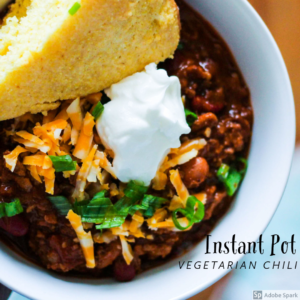 Ingredients:
Ingredients:
2 pounds Beyond beef, or protein alternative
1 small onion finely diced
1 1/2 teaspoons minced garlic
28 ounce can diced tomatoes do not drain
3- 8-ounce cans tomato sauce
3/4 cup vegetable broth or miso broth
2 tablespoons chili powder
2 teaspoons ground cumin
2 teaspoons paprika
2 teaspoons cocoa powder
1 teaspoon granulated sugar
1 1/2 teaspoons kosher salt
3/4 teaspoon ground pepper
15-ounce can kidney beans drained and rinsed
15-ounce can pinto beans drained and rinsedInstructions
Easy Cinnamon Apple Crisps
Who doesn’t think of apples when they think about Fall? Did you know the only apple indigenous to the US is the crab apple? Sweet, tart, crisp, and juicy, what more is there to love about this fruit?
October is National Apple Month. Enjoying in-season produce can be beneficial to a budget and to taste. Apples are filled with antioxidants and soluble fiber. There are several different varieties of apples. Red Delicious, Gala, Fuji, Granny Smith and Honeycrisp- to name a few. Each variety offers it’s own unique flavor, sweetness, crisp and moisture content.
Here’s a simple recipe for those spare apples you have on the counter.
All you need for this recipe are 3 pounds of apples (about 6 medium-sized apples)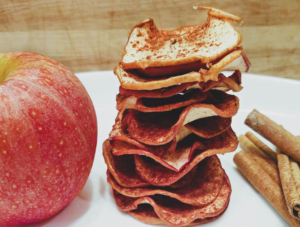 and cinnamon.
and cinnamon.
Tips:
- Cinnamon apple crisps can be stored in an airtight container at room temperature for up to 1 week.
- Enjoy in your Greek yogurt, oatmeal, or as a topping for salads.
Meal Planning Saves Time and Stress
Meal planning and food prep are hands down some of the simplest ways to feed your family healthy, nourishing meals during the week. With busy schedules, it can be tough to make home-cooked meals each day of the week.
Earlier this summer, we talked about ways to navigate the supermarket with ease. We’ve found that even small steps such as cutting vegetables or fruits ahead of time can save a tremendous amount of time during the week.
After you consider your budget, flavors, and the time you have to devote to cooking, here are some ideas on conquering meals throughout the week.
We will give some tips on meal planning breakfast, lunch and dinners. 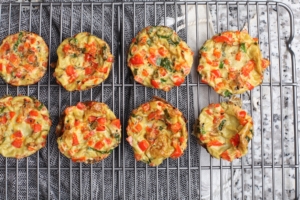
Breakfast
Mornings can be crazy and you need something nourishing and fast.
If you like breakfast items like steel-cut oats or pancakes, preparing these beforehand can save a lot of time in the morning scramble. Oats and pancakes can be saved in a medium-sized container or portioned out and warmed up in the morning before heading out the door.
Other fantastic breakfast ideas include:
- Hard-boiled eggs
- Breakfast bakes
- Mini frittatas
- Toast with nut butter or smoked salmon and/or avocado
- Fruit
- Granola bars
Lunch
Keep lunches simple with 1 or 2 proteins such as chicken, tofu, beans, fish, lean beef, a grain such as quinoa, brown rice, pasta, corn, whole grain bread, and some fruit or veggies.
We like to grill some chicken thighs, make a pot of beans, and roast different veggies such as turnips, carrots, and parsnips to throw into yummy lunch bowls. To make things even easier during the week– allow some extra time to put together 5 containers with your lunch combinations. All that is needed in the morning is to grab your lunch and go!
*You can never go wrong with a sandwich: whole grain bread of choice, some cheese, turkey, roast beef, tofu, salmon, and/or veggies. Easy!
Dinner
If you can come up with 3 dinner ideas for the week, you are virtually set for 6 days of eating. This ensures variety but also the ability to just heat up food some nights – no cooking involved. Realize that meals can be simple – side of pasta, grilled zucchini, grilled chicken – or complex – turkey chili, lasagna, etc. You can even plan for a night of take-out or restaurant eating.
As with any routine change, it takes practice and time to create a lifestyle habit. Start off small with a few prepped ingredients and build your way up to a week’s worth. You too can conquer meal planning and feed your family nourishing meals during the week.
Pick a day to make all or some of your meals for the week. Carving out time early in the week (we like Sunday) and begin your food prep. You can make oatmeal and put individual portions in containers, roast off vegetables, cut up fruit for easy side dishes or snacking, put together veggie bags (cherry tomatoes, carrots, celery, peppers), make 1 or 2 of your dinners for the first half of the week, grill off proteins for lunches.
Though preparation takes time, it makes the rest of your week so much easier as the work is already done and you can just enjoy the fruits of your labor.
As the week goes by, you’ll have time to squeeze in extra food prep as needed, for the remainder of the week.
MU

